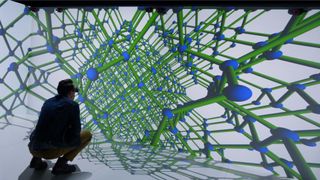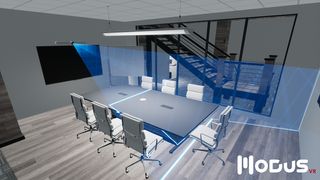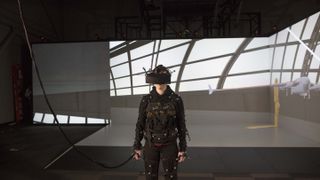Want to dig for cultural artifacts in Egypt? Teleport to the Rocky Mountains during ecology class? How about drawing in three dimensions? Virtual reality (VR) and augmented reality (AR) enable these astonishing feats with spatial computing applications via headsets, tracking software, immersive projection, and mobile apps.
AR and VR, often referenced together as extended reality (XR), have been in use for decades, with gaming leading the charge for consumer adoption. But pandemic-related flux is inspiring commercial stakeholders to reassess XR’s potential. Industries including manufacturing, healthcare, retail, and education are examining the ways immersive technologies can enrich user experiences.
State of the Virtual State
VR costs continue to decrease as processing power increases. Tethered and wireless HMDs (head-mounted displays) are becoming more compact and easier to use. From the HTC Vive Pro 2 to Oculus Quest 2, there are solutions for various budgets. VR is no longer cost-prohibitive.
The AR ecosystem is evolving, too. Apple’s ARKit and free AR mobile apps like Adobe Aero are inviting more people into the content creation space.
It’s a different calculus for adoption in commercial sectors, however. Return on investment and utilization throughout the product lifecycle are primary concerns.
VR Fuels Interdisciplinary Learning
While business has slowed during the coronavirus pandemic, corporations and schools are seizing the moment to evaluate their resources and see how—or even if—VR can assist. With rapid changes in how we work and learn, which investments will yield the most beneficial impacts?
A university can optimize a VR investment by making the resource accessible by more than one department, said Jeff Brum, director of marketing and sales operations at Mechdyne Corp. “VR can be a showcase for the whole school to attract and recruit top talent—both students and professors,” he said. “Imagine a hub facility [with VR] that has a higher utilization rate by multiple departments on campus.”
Just look at Villanova University in Pennsylvania. Villanova has been using a VR Cave Automatic Virtual Environment (CAVE) system for nearly 10 years, with great results. Villanova’s CAVE “supports a multidisciplinary facility within the library, and it’s accessible to every department,” said Brum. During a recent webinar, Brum and Villanova’s tech manager shared ways to make a VR visualization center “like the academic Switzerland” so all disciplines can benefit.

This collaborative approach dovetails with a broader embrace of interdisciplinarity and project-based learning within the academy. It’s a pedagogical trend that VR is uniquely positioned to support.
Remote learning and collaboration have also benefited from VR, AR, and MR (mixed reality). For instance, a middle-school teacher in California, Charles Coomber, used the VR videogame Half-Life: Alyx to meet with students during lockdown in 2020, turning a VR space into a virtual math classroom.
Flexible VR
There are various limitations to headset use, including the isolating effect of wearing a head-mounted display that hides the outside world, and the difficulty in sanitizing headsets between uses. Because these HMDs may limit opportunities for collaboration, some stakeholders are exploring larger-scale systems for group instruction in VR, such as CAVEs, a recursive acronym that stands for Cave Automatic Virtual Environment. Several companies offer CAVE visualization systems. Barco’s CAVE Display is a multisided immersive environment (fixed or transportable) that can be customized to meet various size requirements. For more flexible spaces, a 3D-supported wall is another possible approach. A large format, reconfigurable system can change from a VR CAVE into a wall or angled screen.
AR in Education
Ori Inbar is the co-founder of Super Ventures and the co-founder/CEO of AugmentedReality.org, a global non-for-profit organization dedicated to the advancement of AR. He is also the producer of AWE Expo, an event focused on the AR industry.
Inbar is passionate about AR as an educational tool. “We learn better by doing and simulating, especially projects that are impossible to complete in the classroom,” he said. “We retain information better in 3D and spatially.”
Research backs up these assertions. Studies by the Empathic Computing Lab contextualize the use of AR and VR technologies within various learning modalities. As one research paper concluded, “Augmented reality offers an enhanced learning environment that could potentially influence children’s experience and knowledge gain during the language learning process.” VR has also been proven to assist the treatment of anxiety, phobia, addiction, and pain management, according to the Empathic Computing Lab.
Hundreds of AR-enabled apps have been created to help students learn the fundamentals of science, from the origins of the universe to the extinction of the dinosaurs. Inbar highlighted some notable K-12 games and apps that leverage AR. MagicKids is a box-based learning tool that integrates augmented reality and artificial intelligence so children can “interact with and learn from the world they see every day,” according to MagicKids. Popular augmented books include Bookful by InceptionXR. Complete Anatomy and Visible Body are compelling AR anatomy educational resources. The creative possibilities are endless.
Modus VR: Bridging the Gap

VR flips the script for AV stakeholders in another crucial way: by helping dealers bring AV to life. Modus VR is a powerful sales tool that lets users customize any space in VR, with no modeling experience necessary. A client’s space can be re-created to scale in minutes.
Modus VR is both a solution and a “paradigm shift in AV,” according to Ken Brueck, co-founder of the company. The software as a service (SaaS) application bridges the gap between blueprints and final renders, allowing clients to experience an immersive digital representation of an AV redesign before the first cable is laid. Using Modus VR, dealers can create virtual spaces, walk clients through design options, step by step, and seamlessly export to CAD. Say farewell to traditional blueprints. There’s another bonus—with Modus VR, you can fully demo in 3D without goggles.
Q&A
Like any other project, an XR application must start with designers and integrators asking the right questions. As early as possible, inquire about the areas of work or research that are germane to clients.
Mechdyne’s Brum encourages deep listening. “Ask about their projects,” he said. “Where’s the data coming from? What is their source material? What are they trying to create or present? What’s the class size? How often will the space or system be used by the school for recruitment? Will it be used expansively, within a multidisciplinary space, or for a STEAM program? Do you need a hosting room out front? What computing is required? What would the bring-your-own-device [BYOD] model look like?”
Brum added that, when considering a VR space, related non-VR elements, such as a hosting room, are just as important to understand.
Lifecycle and Upgrades
“Villanova is in its eighth year with a CAVE, and they’ve been viable all the way along,” said Brum. He also pointed out the virtual reality labs at Rowan University have been generating insights for 13 years. Iowa State University has had various immersive VR solutions for more than two decades—“including their showcase 100-million pixel, six-sided CAVE.”
One of Mechdyne’s clients has an auditorium that’s VR-equipped with a “gigantic 30-foot diagonal screen. It offers 3D functionality, so they can do 3D teaching with 3D modeling plus standard presentations.”
The key for longevity, Brum explained, is planning for flexible and usable applications that will attract multiple users. Plan for regular maintenance and upgrade paths. Where possible, perform upgrades, both hardware and software, over time to keep the system performing optimally and generating results. With proven results comes the opportunity to upgrade even more.
Some of the company’s government and academic clients started with an immersive desk, then gradually moved up to a fully immersive VR system. “A flexible configuration will allow the client to accommodate multiple disciplines,” Brum added.
Solutions
Barco, Christie Digital, Digital Projection, Epson, and Sony are a few pro AV vendors that offer VR and immersive 3D projection solutions. “We offer platforms, so virtually every system we do is customized in some way, shape, or form, because we are vendor neutral,” said Brum.
“We always look at the application first. We look at the use cases and the overall goals, then we select the components that will deliver on those needs.” When collaboration and user requirements expand beyond head-mounted displays (HMDs), specifying and combining the right computing, displays, and software is not straightforward.
[Future Vision: Volvo Tests New Car Designs by Driving With an XR Headset]
Inflection Point?
COVID is still disrupting work and life across the globe, but 2021 also represents a year when the VR elements—hardware, software, processing power—have become more accessible. Especially for HMDs, computing power is increasing, resolution is increasing, and there is more content available, thanks in part to advances with Unity and Unreal Engine for content creation.
This alignment is playing out for multinational corporations. Say you want to keep distributed teams connected across the globe. Using the multiplayer model, clients can simulate an industrial workroom to design vehicles, for example, or prototype, with collaboration across distances using headsets. If a company with a design studio in Michigan and factories in China, South America, and Germany wants to keep teams in alignment, it’s possible with VR.
“VR has been around for more than 20 years, but there is still so much potential for us,” concluded Brum. “With form factors changing and headsets getting better, there are so many new opportunities. That’s all happening while the next generation of users and creators are redefining what VR can be.”
Click here to read more stories from the June 2021 issue of SCN.


